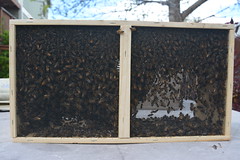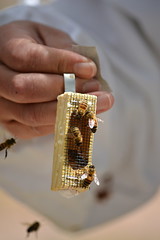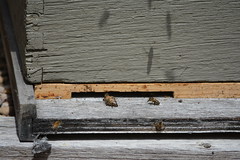I was entirely wrong on all points, and had to take half a day to process what I really found when I went into the hive.
I also kind of resisted going in, as I'd really wanted the bees to just keep all their honey for the winter and not have to deal with them again until they'd started to pack up for the cold; but it all kept nagging at me, as they'd been so quick to fill the supers the first time around. So to be responsible to them, I had to go in.
So I did.
 On Monday, the 4th, I went in to see what there was to see. Despite all the smoke from the local forest fires, I decided to use smoke to calm the bees 'cause it's more effective than the sugar syrup spray; and by late summer, they're having to defend their hive from other bees and wasps constantly. So they get really defensive and feisty when I go in, so it's better all around that I just use smoke and get them to go feed while I get things opened up to where I want to get.
On Monday, the 4th, I went in to see what there was to see. Despite all the smoke from the local forest fires, I decided to use smoke to calm the bees 'cause it's more effective than the sugar syrup spray; and by late summer, they're having to defend their hive from other bees and wasps constantly. So they get really defensive and feisty when I go in, so it's better all around that I just use smoke and get them to go feed while I get things opened up to where I want to get.I like applying the smoke and then letting them feed for a while before I go in and start opening things up. It gives me a chance to get everything ready and it gives them a chance to have some honey and fill their bellies so that they don't sting me. John and I actually sat and talked for a good hour over exactly what it was I was going to do, what it was that I needed to figure out, and what the further actions would be given what data I got.
 And the first thing I find is that they've build honeycomb all the way onto the lid. It's a good way of keeping down drafts and robbers through the main body of the hive, keeping all incoming to the outside frames; however, when they stick the whole thing to the top, it's kind of a pain to get the lid off.
And the first thing I find is that they've build honeycomb all the way onto the lid. It's a good way of keeping down drafts and robbers through the main body of the hive, keeping all incoming to the outside frames; however, when they stick the whole thing to the top, it's kind of a pain to get the lid off.Sure enough, the girls had filled all the frames completely full, which was why they'd built above it all as well. All the way to the edge frames, too, which they normally leave only half filled, but with the spacing and everything, they'd filled all of them completely with capped honeycomb, which meant that the honey was completely finished and dried enough to store for nearly ever.
I moved both supers so that I could take a look into the brood chamber, too, as I needed to assess if they had varroa mites, which has been one of the leading causes of colony deaths. And the local Beekeepers' Association had a full out educational thing going on about how everyone could test for the mites by rolling the bees in powdered sugar. The powdered sugar dislodges the mites from the bees, and it has very little impact on the bees themselves, and with in 24 hours, the mites drop off and can be pulled out of the hive with a removable bottom board, which I have.
But that only happens when the bees have mites, and the idea is to put a cup of bees into a glass quart jar, pour powdered sugar on them, and then roll them in it. Then shake all the sugar out with the mites and then release the bees, ghost white from sugar but still entirely alive and unharmed. The mites fall off quickly, so you can get a count of them; and I could test how many were in there.

When I got down into the brood boxes and the frames down there, I found that the frames were completely filled with honey and pollen. They had huge stores in there, and they were all full, too. So that answered the question of if they'd already put away good stores for the winter...
And when I pulled the brood frame out, I shook bees into a glass jar and tested them for mites. There wasn't a single dead mite. And on the bottom board, I had only seen one mite all summer. The usual level where you want to control the mites is if there's more than 2 mites per hundred bees. To have absolutely none of them in the hive at all meant that the girls were doing great at avoiding infestation.
It was an unexpectedly good result to the test. I was really expecting there to be some, and there just weren't any. And the chemical treatments that are commonly used are detrimental to the hive, if you think about it, it makes sense, as you're basically trying to kill a smaller bug riding on a bigger bug without harming the bigger bug too much, and it's a tricky thing to kill one without killing the other.
 However... since the powdered sugar serves to a) loosen mites if there are any, b) have the girls clean the mites off each other if there are any with the powdered sugar coating, c) powdered sugar is something they can just eat and has no adverse affects on the bees themselves, and d) it's cheap and easy to apply: I decided to just go ahead an apply the stuff.
However... since the powdered sugar serves to a) loosen mites if there are any, b) have the girls clean the mites off each other if there are any with the powdered sugar coating, c) powdered sugar is something they can just eat and has no adverse affects on the bees themselves, and d) it's cheap and easy to apply: I decided to just go ahead an apply the stuff.Then I put the supers back on, closed it all up and went and sat in the kitchen trying to figure out what to do next. Most beekeepers at this time of year just have three responsibilities, get the supers off the hive and collect the honey, treat for mites if that's necessary, and make sure that the bees will have enough stores for the winter.
I had been assuming that I'd just leave all the honey for the girls for the winter, and that they'd need that. But they obviously didn't. They'd filled everything to the brim already, and if anything, they had nothing to really do for the remaining month and a half before the first frost and the flowers went away. There were still plenty of flowers around, and these are domesticated bees, bred and made to create honey and wax that needs to be taken away for them to fulfill their commercial duties.
I also narrowed the front entrance so that the robber bees and wasps would have a harder time making it in, and I removed the shims from the top of the hive, so that there wouldn't be as easy an access to the insides. It was a good thing, too, as the temps fell into the 40's that night, and closing it up made it easier for them to keep things warm inside.
So... it took me a few days, but on Thursday, we pulled the entire top super and two of the frames in the lower super, and we extracted all of them, and I put the two empty frames back into the lower super so that the girls would have something to do. The whole lower super was completely full of honey, too, so I was leaving them six full frames there along with the completely full deep.

We got a lot of honey. We extracted everything and then put the empty super back onto the hive to let the girls clean up all the drips and the last bits in the emptied comb. I'll probably collect the emptied super on Saturday so that they have a day to clean it out.
So we had 2 1/2 gallons in the first harvest and probably another 3.25 gallons in the second. And there's likely 3 left in the remaining super and another five to seven in the two deep brood boxes from the heft of those things. So the bees will have plenty for the winter, and they have time, still, to refill the remaining two super frames in the super that I left them. I'm definitely going to leave them that for the winter and only collect that honey in the spring if it's still there.
That should allow me to not feed them over the winter and early spring; and should let them have plenty of the good enzymes and stuff in their honey that they can get. And, worst case, I can probably just pour a quart or two of their honey into a feeder for them if they do need it by then.
One of the girls managed to get into the pants of my beekeeper suit when I was putting the super back onto the hive, and she stung me solidly. It hurt, but it didn't swell at all, so I have to say that the bee venom therapy I had through my allergy clinic worked really well.
But all in all, it was kind of weird to realize that these domesticated bugs really were created to make honey that needed to be taken from them for them to function correctly. That I had to go in and get all that and it was how they're made. In order for me to shorten their hive enough so that they can keep it good and warm, I have to take at least one of the supers off before winter; but it felt weird when I really had initially decided that I was just going to leave them the honey they'd worked so hard to get.
Still, now, if I sell a lot of this, I will make up all the extra money I had to pay for the colony during the bee shortage; and with the extra money, I should be able to buy another super and frames for them and maybe also make sure I have solid mite treatments for next year. They've mostly already paid for the extractor and their own costs. That's been pretty amazing.












